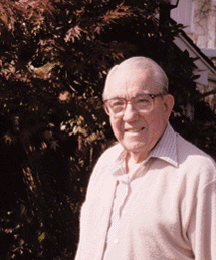
 |
By David G. Gordon, Washington Sea Grant Program |
| New England has its clam chowder, but Washington can boast the best oyster stew around. The origins of this creamy concoction go back 150 years, to the days of the California Gold Rush. "Take the Liquor and the same quantity of Fresh Milk, put it into a stew-pan, season with Salt, Pepper, etc.," read the instructions on a can of oysters from those days. "When boiling, pour the Liquor on the Oysters, they are then ready to serve up." Smooth and savory oyster stew remained a staple among Northwest shellfish growers and gourmands long after California's gold fever subsided. However, it wasn't until the 1950s, when Willapa Bay resident Ed Gruble began marketing canned oyster stew, that this flavorful regional dish became a true household word. |
|
|
Gruble left the produce business to become an oysterman in the late 1940s, when Coast Oyster Company expressed interest in leasing his fleet of delivery trucks. An offer to oversee Coast's South Bend, Washington, cannery soon followed-- and Gruble leapt at the chance. After studying the ins and outs of the industry, the young entrepreneur eventually quit his job to start his own shellfish plant, the Willapa Bay Oyster Company in 1952. Here, opportunity knocked, in the form of 100,000 gallons of shucked Pacific oysters, delivered to the plant in 10-gallon milk cans. "These were huge oysters, four or five to a pint, and their size made them less desirable for canning," Gruble remembers. "They were just sitting there with no place to go, depressing the market for fresh oysters with their mass." That's when Gruble came up with the idea of slicing the surplus Pacifics and adding them to canned oyster stew. Coming up with a winning formula for a canned product, however, proved more difficult than Gruble or his coworkers could have guessed. "You have an oyster with a pH of 6.0 and milk with a pH that's considerably higher, around 6.5" Gruble explains. "Put the two together and it's like a chemistry experiment. The difference causes the milk to curdle and ruin the product." Previously, oyster processors had tried unsuccessfully to mask the unappetizing effects of curdling, using thickeners and other ingredients. Gruble turned to the region's cheese makers for advice about stabilizing the milk-and-oyster mix. Their advice, which Gruble still keeps to himself, did the trick. "The balance of oysters, oyster nectar, milk and seasoning had to be just right to please the public," says Gruble. "And apparently we did it, because we became the nation's number-one seller of canned oyster stew." In 1954, Gruble joined forces with Vernon Hunt of Atherton, California and Hamilton Dowell of Seattle to form Hilton Seafoods Company, Inc. The trio moved the base of operations to Seattle, which, while further from the oyster beds, was closer to shipping outlets and sources of processing supplies. At its peak, Hilton's 64 employees cranked out 3,000 cases of eight and 10-ounce cans—some 5,000 gallons of oyster stew every business day. The cans were stored in as many as 60 warehouses and handled by a team of 85 oyster stew brokers in the U.S., Puerto Rico and Canada. "Heinz tried to compete with us, and so did Campbell's Soup, but we had the market for stew all sewn up," Gruble now gloats. Primarily Atlantic coast operations, these competitors lacked supplies of Pacific oysters and were forced to make do with the smaller, less nectar-rich Eastern oysters. After 25 years in the business, the czar of oyster stew sold his top-secret formula to the Boston-based New England Fish Company. That recipe was handed to Hilton's Brand of Bedford, when New England Fish filed for bankruptcy in 1979, three years after Gruble retired from the oyster biz. Now enjoyed by diners worldwide, oyster stew remains synonymous with life in the Northwest, regardless of its point of manufacture. |
|